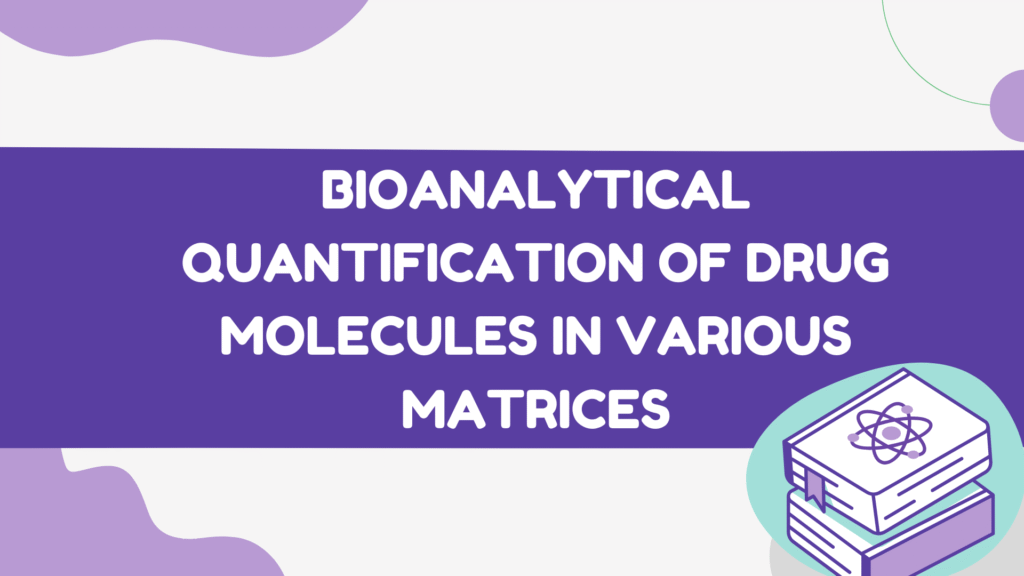Bioanalytical Quantification of Drug Molecules in Various Matrices

Introduction
Bioanalytical quantification is a pivotal aspect of pharmaceutical research and development, ensuring accurate measurement of drug molecules in biological matrices. This process is essential for assessing drug efficacy, safety, and pharmacokinetics. At Resolvemass Laboratories Inc., we offer expert bioanalytical quantification services for drug molecules in various matrices, providing precise and reliable results to support your research and development needs.
What is Bioanalytical Quantification?
Bioanalytical quantification involves the measurement of drug molecules and their metabolites in biological samples, such as blood, plasma, serum, urine, and tissues. This process uses advanced analytical techniques to determine the concentration of drug substances, which is crucial for evaluating drug absorption, distribution, metabolism, and excretion (ADME).
Techniques Used in Bioanalytical Quantification
- Liquid Chromatography-Mass Spectrometry (LC-MS): LC-MS combines the separation power of liquid chromatography with the detection capabilities of mass spectrometry. It is widely used for its high sensitivity and specificity in quantifying drug molecules and metabolites in complex biological matrices.
- High-Performance Liquid Chromatography (HPLC): HPLC separates drug molecules based on their interactions with the chromatographic column. It is often used in conjunction with UV or fluorescence detection for quantifying drug concentrations.
- Enzyme-Linked Immunosorbent Assay (ELISA): ELISA is a popular immunoassay technique that uses antibodies to detect and quantify drug molecules in biological samples. It is particularly useful for biomarker analysis and large-scale screening.
- Gas Chromatography-Mass Spectrometry (GC-MS): GC-MS is used for the analysis of volatile and semi-volatile compounds. It combines gas chromatography for separation with mass spectrometry for detection and quantification.
Applications of Bioanalytical Quantification
- Pharmacokinetic Studies: Determining the absorption, distribution, metabolism, and excretion of drug molecules to understand their behavior in the body.
- Clinical Trials: Monitoring drug levels in patient samples to ensure appropriate dosing and evaluate therapeutic efficacy.
- Drug Development: Assessing drug stability, formulation, and interaction with biological systems.
- Regulatory Compliance: Meeting the requirements of regulatory agencies by providing accurate and validated bioanalytical data.
Advantages of Our Bioanalytical Services
- Precision and Accuracy: We employ advanced techniques and rigorous validation processes to ensure high accuracy and reproducibility in drug quantification.
- Experienced Team: Our skilled scientists have extensive experience in bioanalytical method development and validation, ensuring reliable results.
- Diverse Matrix Analysis: We offer quantification services for a wide range of biological matrices, including plasma, serum, urine, and tissues.
- Custom Solutions: We provide tailored bioanalytical services to meet your specific needs, including method development, validation, and sample analysis.
Our Expertise at Resolvemass Laboratories Inc.
At Resolvemass Laboratories, we are dedicated to providing high-quality bioanalytical quantification services. Our capabilities include:
- Advanced Analytical Equipment: We utilize state-of-the-art LC-MS, HPLC, and GC-MS systems to deliver accurate and sensitive quantification.
- Comprehensive Services: Our services cover all aspects of bioanalytical quantification, from method development and validation to sample analysis and data interpretation.
- Regulatory Expertise: We ensure that our methods and results comply with regulatory standards and guidelines, supporting your drug development and clinical research needs.
Conclusion
Bioanalytical quantification is essential for understanding drug behavior and ensuring drug safety and efficacy. At Resolvemass Laboratories Inc., we provide expert services for the precise measurement of drug molecules in various biological matrices. Contact us today to learn more about how our bioanalytical quantification services can support your research and development objectives.
FAQs on Bioanalytical Quantification of drug molecules in various matrices
What is bioanalytical quantification and why is it important in drug development?
Bioanalytical quantification is the measurement of drug molecules and/or their metabolites in biological matrices (like plasma, serum, urine, tissues) using analytical techniques. It is essential for understanding pharmacokinetics (absorption, distribution, metabolism, excretion), safety, efficacy, and dosing of a drug. Without reliable quantification, regulatory approval and therapeutic monitoring would be compromised.
Common matrices include plasma, serum, whole blood, urine, saliva, cerebrospinal fluid, tissues, and sometimes special fluids like bile. Choice depends on the pharmacological properties of the drug, its route of administration, the drug’s distribution, and the ease and invasiveness of sampling.
Each matrix has unique properties: for example, plasma/serum has proteins that can bind drugs; urine may contain salts and variable pH; tissues require homogenization; low-protein matrices may lead to analyte loss due to nonspecific binding. These features can affect extraction, stability, sensitivity, and the risk of matrix effects (interference with detection).
A matrix effect refers to alteration of the analytical signal (suppression or enhancement) caused by other components in the biological matrix, which co-elute or interfere with the analyte’s detection (e.g. in LC-MS/MS). Matrix effects can distort the true concentration unless appropriately evaluated and corrected during method validation.
Key validation parameters include selectivity/specificity, sensitivity (lower limit of quantification, LLOQ), accuracy, precision (intra- and inter-day), calibration curve (linearity), range (LLOQ to upper limit of quantification, ULOQ), stability (during storage, freeze-thaw, post-preparation), carryover, dilution integrity, and matrix effects. Also, documentation and reproducibility are required.
Drug molecules can degrade or change (by chemical breakdown, adsorption to container, enzymatic action) if samples are not handled or stored properly. Stability under conditions such as room temperature, refrigerated or frozen storage, freeze-thaw cycles, and during sample processing must be assessed. Improper handling can lead to underestimation or misestimation of drug concentrations.
References
- Pawar, S. V., & Gaware, V. M. (2025). A review on: Bioanalytical method development and validation. Asian Journal of Pharmaceutical Research and Development, 13(3), 167-179. https://ajprd.com/index.php/journal/article/download/1578/1606
- Tijare, L. K., Rangari, N. T., & Mahajan, U. N. (2016). A review on bioanalytical method development and validation. Asian Journal of Pharmaceutical and Clinical Research, 9(Suppl. 3), 6-10. https://doi.org/10.22159/ajpcr.2016.v9s3.14321
- Czyż, A., Zakrzewska-Sito, A., & Kuczyńska, J. (2024). A review of advances in bioanalytical methods for the detection and quantification of olanzapine and its metabolites in complex biological matrices. Pharmaceuticals, 17(3), 403. https://doi.org/10.3390/ph17030403